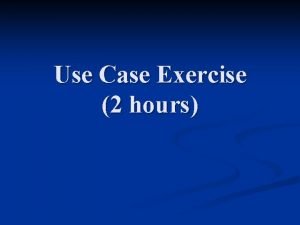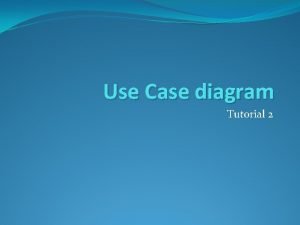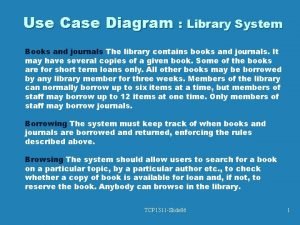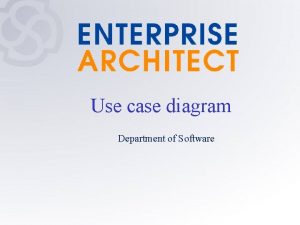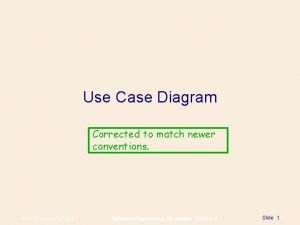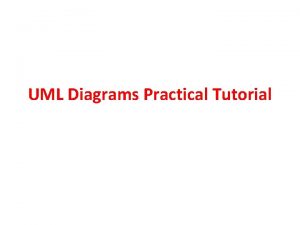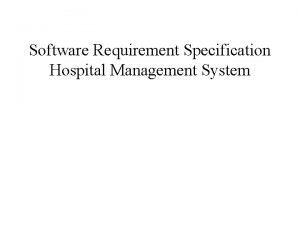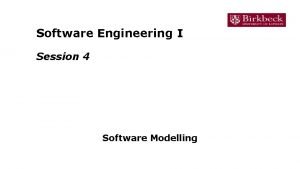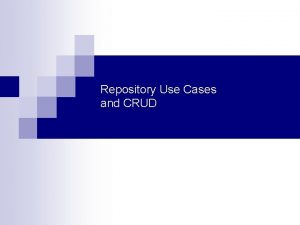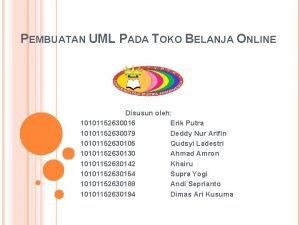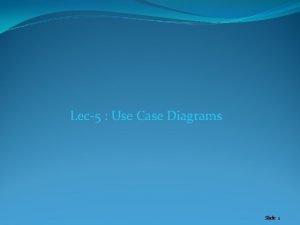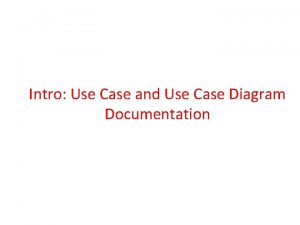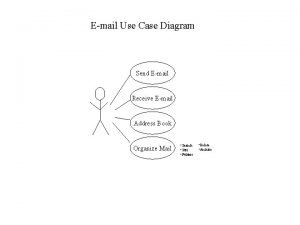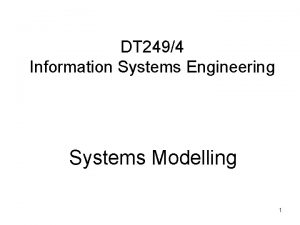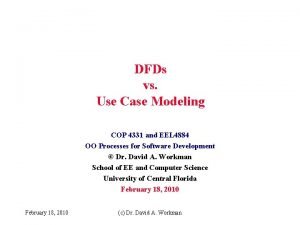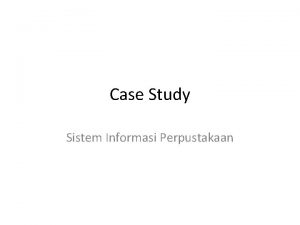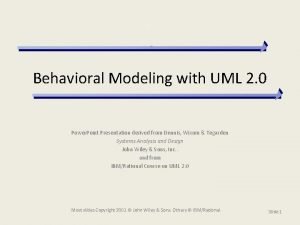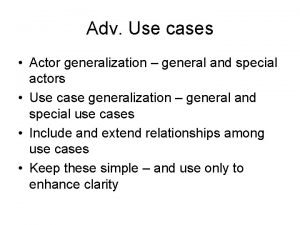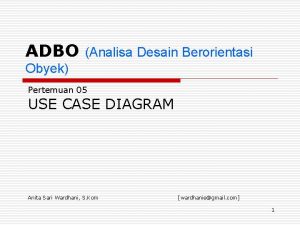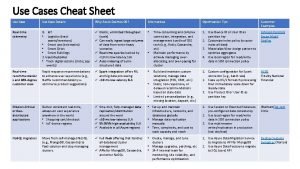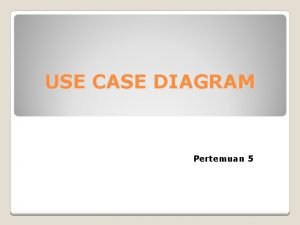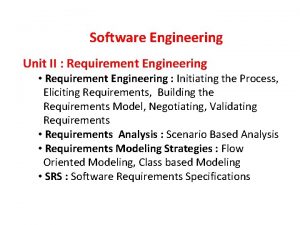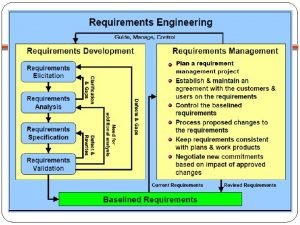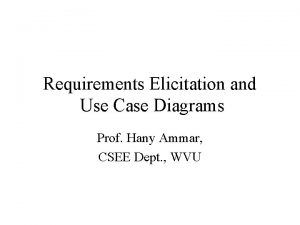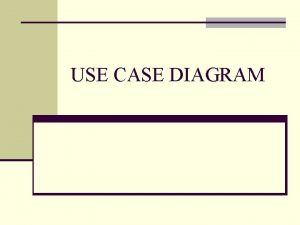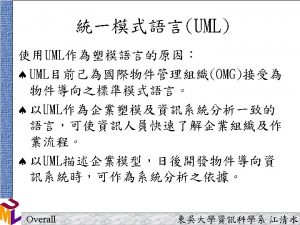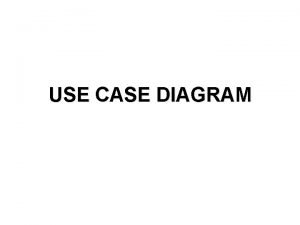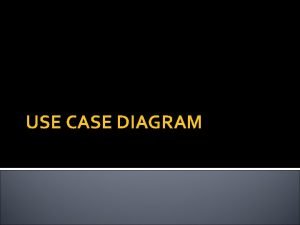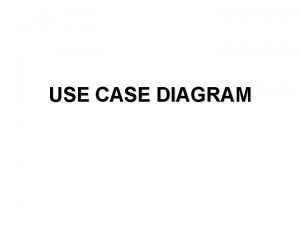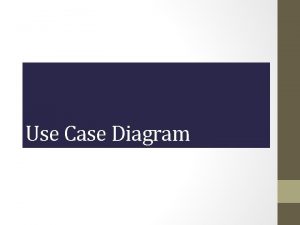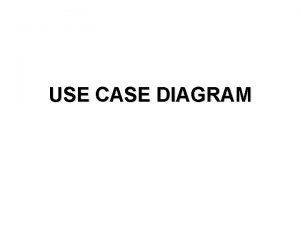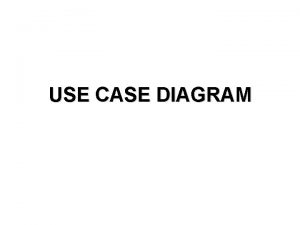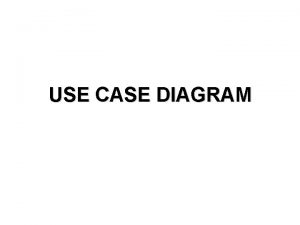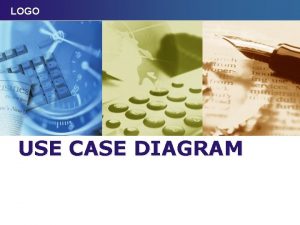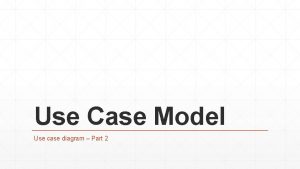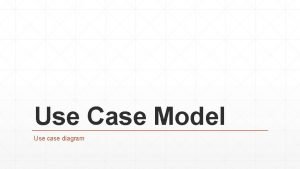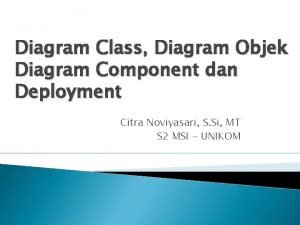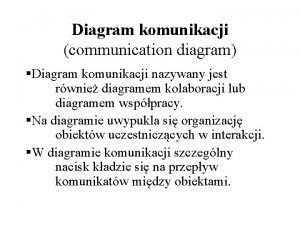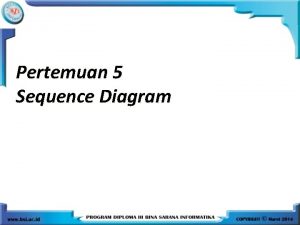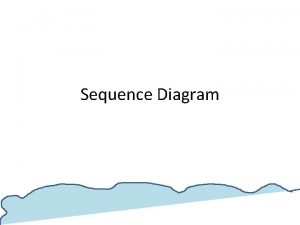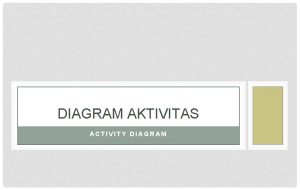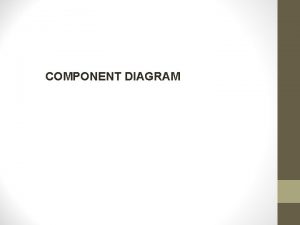Use Case Model Use case diagram Part 1


































- Slides: 34

Use Case Model Use case diagram –Part 1

Relevant Requirements Artifacts Use-Case Model Glossary Actors Use Cases . . . Supplementary Specification Use-Case Specifications ٥

What Is System Behavior? System behavior is how a system acts and reacts. It is the outwardly visible and testable activity of a system. System behavior is captured in use cases. Use cases describe the system, its environment, and the relationship between the system and its environment. ٨

What Are the Benefits of a Use-Case Model? o Communication o Identification o Verification Communication Use Case Verification Identification End Users Domain Expert ١٢ OOAD

Key points ▪ The development team, with stakeholders involvement, writes the use cases. ▪ Compared to traditional requirement methods, use cases are relatively easy to write and easier to read. ▪ Free of technical or implementation details.

Use Cases ▪ What is a Use Case ØA formal way of representing how a business system interacts with its environment ØIllustrates the activities that are performed by the users of the system ØA scenario-based technique in the UML

Use Case Diagrams q. A use case diagram depicts the interactions between the system and the external actors. 7

Use Cases ▪ Use case diagrams describe what a system does from the standpoint of an external observer. The emphasis is on what a system does rather than how. ▪ Use case diagrams are closely connected to scenarios. A scenario is an example of what happens when someone interacts with the system.

Developing use case diagram Actor is a stick figure usually an actual person using the system System name System boundary Connection line shows which actor participate in the use cases The use case 9

Major Concepts in Use-Case Modeling ▪ An actor represents anything that interacts with the system. ▪ An actor might be: ▪ a person ▪ a company or organization, ▪ a computer program, or a computer system Actor ▪ Hardware ▪ A use case is a sequence of actions a system performs that yields an observable result of value to a particular actor. ▪ Name each use case using Noun-Verb Use. Case ٩ OOAD

Use Case Analysis ▪ What is an Actor? ▪ A user or outside system that interacts with the system being designed in order to obtain some value from that interaction ▪ Use Cases describe scenarios that describe the interaction between users of the system (the actor) and the system itself.

Questions for Identifying People Actors ▪ Who is interested in the scenario/system? ▪ Where in the organization is the scenario/system be used? ▪ Who will benefit from the use of the scenario/system? ▪ Who will supply the scenario/system with this information, use this information, and remove this information? ▪ Does one person play several different roles? ▪ Do several people play the same role?

Questions for Identifying Other Actors ▪ What other entity is interested in the scenario/system? ▪ What other entity will supply the scenario/system with this information, use this information, and remove this information? ▪ Does the system use an external resource? ▪ Does the system interact with a legacy system?

Types of actor ▪ Primary actor initiates the use case. ▪ Secondary actor is used to complete the use case. ▪ E. g. the professor send SMS to the students. The professor considered as primary actor, whereas students considered as secondary actor

Actors ▪ An Actor is outside or external the system. ▪ It can be a: ▪ Human ▪ Peripheral device (hardware) ▪ External system or subsystem ▪ Time or time-based event ▪ Represented by stick figure

A Step-by-Step Guide to Building the Use. Case Model ▪ Step 1: Identify and Describe the Actors ▪ Who uses the system? ▪ Who gets information from this system? ▪ Who provides information to the system? ▪ Where in the company is the system used? ▪ Who supports and maintains the system? ▪ What other systems use this system? 16

A Step-by-Step Guide to Building the Use. Case Model ▪ Step 2: Identify the Use Cases and Write a Brief Description ▪ What will the actor use the system for? ▪ Will the actor create, store, change, remove, or read data in the system? ▪ Will the actor need to inform the system about external events or changes? ▪ Will the actor need to be informed about certain occurrences in the system? 17

A Step-by-Step Guide to Building the Use. Case Model ▪ Step 3: Identify the Actor and Use-Case Relationships ▪ Only one actor can initiate a use case ▪ Many use cases may involve the participation of multiple actors. ▪ Each use case is analyzed to see what actors interact with it 18

Use case diagram 19

Use Cases ▪ Here is a scenario for a medical clinic. ▪ A patient calls the clinic to make an appointment for a yearly checkup. The receptionist finds the nearest empty time slot in the appointment book and schedules the appointment for that time slot. " ▪ We want to write a use case for this scenario. ▪ Remember: A use case is a summary of scenarios for a single task or goal.

Use Cases ▪ Step 1 Identify the actors ▪ As we read the scenario, define those people or systems that are going to interact with the scenario. ▪ A patient calls the clinic to make an appointment for a yearly checkup. The receptionist finds the nearest empty time slot in the appointment book and schedules the appointment for that time slot. "

Use Cases ▪ A use case is a summary of scenarios for a single task or goal. ▪ An actor is who or what initiates the events involved in the task of the use case. Actors are simply roles that people or objects play. ▪ So as we read our scenario, what or who is the actor? ?

Use Cases ▪ So as we read our scenario, what or who is the actor? ? ▪ A patient calls the clinic to make an appointment for a yearly checkup. The receptionist finds the nearest empty time slot in the appointment book and schedules the appointment for that time slot. " ▪ The actor is a Patient.

Use Cases ▪ The use case is a summary of scenarios for a single task or goal. ▪ So What is the Use Case? ? ▪ The Use Case is Make Appointment. ▪ It is a use case for the medical clinic.

Use Cases ▪ The picture below is a Make Appointment use case for the medical clinic. ▪ The actor is a Patient. The connection between actor and use case is a communication association (or communication for short). Actors are stick figures. Use cases are ovals. Communications are lines that link actors to use cases.

Use Case Componentss ▪ The use case has three components. ▪ The use case task referred to as the use case that represents a feature needed in a software system. ▪ The actor(s) who trigger the use case to activate. ▪ The communication line to show the actors communicate with the use case.

Use Case ▪ Each use case in a use case diagram describes one and only one function in which users interact with the system ▪ May contain several “paths” that a user can take while interacting with the system ▪ Each path is referred to as a scenario

Use Case ▪ Labelled using a descriptive verb-noun phrase ▪ Represented by an oval Make Appointment

Use Case - Actor ▪ Labelled using a descriptive noun or phrase ▪ Represented by a stick character

Use Case - Relationships ▪ Represent communication between actor and use case ▪ Depicted by line or double-headed arrow line ▪ Also called association relationship Make Appointment

Use Case - Relationships ▪ Boundary ▪ A boundary rectangle is placed around the perimeter of the system to show the actors communicate with the system. Make Appointment

Use-Case Diagram A use case diagram is a collection of actors, use cases, and their communications.

Case Study: Course Registration Problem. Statement Review the problem statement provided in the Course Registration Requirements Document ٦ OOAD

How Would You Read This Diagram? View Report Card Course Catalog Register for Courses Maintain Professor Information Student Maintain Student Information Login Registrar Select Courses to Teach Close Registration Professor Submit Grades Billing System OOA D ١٣
 Uml adalah
Uml adalah Best case worst case average case
Best case worst case average case Use case diagram exercises
Use case diagram exercises Use case tutorial
Use case tutorial Library use case diagram
Library use case diagram Use case diagram symbols
Use case diagram symbols Video rental system use case diagram
Video rental system use case diagram Mhc-pms use case diagram
Mhc-pms use case diagram Use case diagram game example
Use case diagram game example Hospital management system deployment diagram
Hospital management system deployment diagram Use case diagram software engineering
Use case diagram software engineering Use case diagram for mentcare system
Use case diagram for mentcare system Crud use case diagram
Crud use case diagram Sequence diagram penjualan online
Sequence diagram penjualan online Alarm clock use case diagram
Alarm clock use case diagram Point of sale use case diagram
Point of sale use case diagram Fitness center class diagram for gym management system
Fitness center class diagram for gym management system Email use case diagram
Email use case diagram Use case diagram of employee management system
Use case diagram of employee management system Mhc-pms use case diagram
Mhc-pms use case diagram Activity diagram
Activity diagram Dfd vs use case diagram
Dfd vs use case diagram Activity diagram for access camera surveillance
Activity diagram for access camera surveillance Use case diagram perpustakaan
Use case diagram perpustakaan Uml
Uml Use case diagram augmented reality
Use case diagram augmented reality Use case diagram for ecommerce website
Use case diagram for ecommerce website Use case generalization example
Use case generalization example Use case diagram mesin atm
Use case diagram mesin atm Cosmos cheat
Cosmos cheat Use case generalisasi
Use case generalisasi What is data flow diagram in software engineering
What is data flow diagram in software engineering Mhc-pms use case diagram
Mhc-pms use case diagram Use case diagram example
Use case diagram example Use case diagram rules
Use case diagram rules


